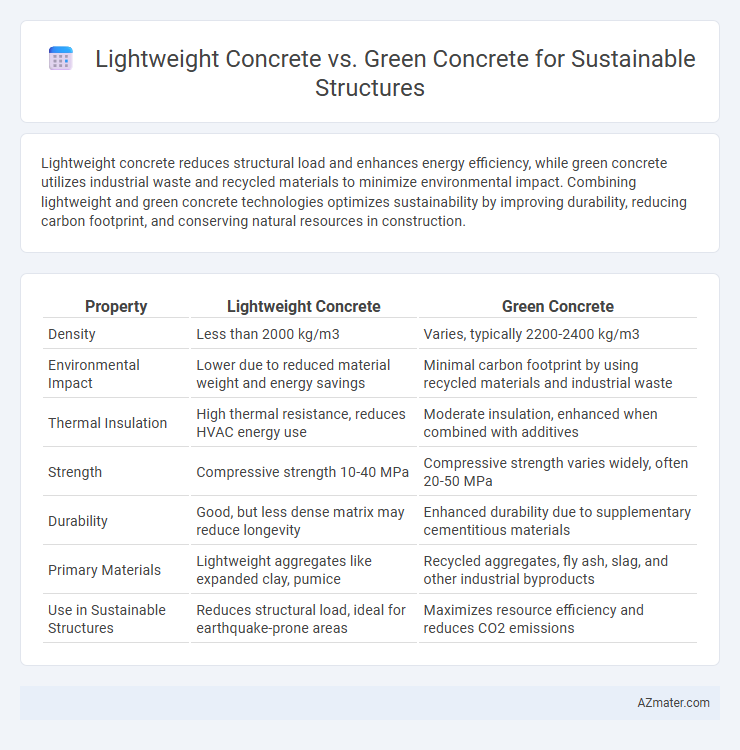Lightweight concrete reduces structural load and enhances energy efficiency, while green concrete utilizes industrial waste and recycled materials to minimize environmental impact. Combining lightweight and green concrete technologies optimizes sustainability by improving durability, reducing carbon footprint, and conserving natural resources in construction.
Table of Comparison
| Property | Lightweight Concrete | Green Concrete |
|---|---|---|
| Density | Less than 2000 kg/m3 | Varies, typically 2200-2400 kg/m3 |
| Environmental Impact | Lower due to reduced material weight and energy savings | Minimal carbon footprint by using recycled materials and industrial waste |
| Thermal Insulation | High thermal resistance, reduces HVAC energy use | Moderate insulation, enhanced when combined with additives |
| Strength | Compressive strength 10-40 MPa | Compressive strength varies widely, often 20-50 MPa |
| Durability | Good, but less dense matrix may reduce longevity | Enhanced durability due to supplementary cementitious materials |
| Primary Materials | Lightweight aggregates like expanded clay, pumice | Recycled aggregates, fly ash, slag, and other industrial byproducts |
| Use in Sustainable Structures | Reduces structural load, ideal for earthquake-prone areas | Maximizes resource efficiency and reduces CO2 emissions |
Introduction to Sustainable Structures
Lightweight concrete reduces structural load and improves energy efficiency through its low density and thermal insulation properties, making it ideal for sustainable structures. Green concrete incorporates waste materials and industrial byproducts, minimizing environmental impact by reducing carbon footprint and resource consumption during production. Both materials contribute to sustainable construction by enhancing durability, reducing emissions, and promoting eco-friendly building practices.
Defining Lightweight Concrete
Lightweight concrete is a type of concrete characterized by reduced density due to the use of lightweight aggregates such as expanded clay, shale, or pumice, leading to improved thermal insulation and lower dead load on structures. It offers advantages in construction by enhancing energy efficiency and reducing material consumption, which supports sustainability goals in structural design. Compared to green concrete, which focuses more on eco-friendly materials and reduced carbon footprint, lightweight concrete primarily targets structural efficiency and resource optimization in sustainable building practices.
What is Green Concrete?
Green concrete is an eco-friendly building material that incorporates industrial waste by-products like fly ash, slag, or recycled aggregates, reducing carbon emissions compared to traditional concrete. It promotes sustainability by minimizing the use of natural resources and lowering the environmental impact of construction projects. Unlike lightweight concrete, which primarily focuses on reduced density and improved insulation, green concrete emphasizes environmental benefits and resource efficiency.
Material Composition and Sources
Lightweight concrete primarily consists of natural lightweight aggregates such as expanded clay, shale, or pumice, reducing the overall density and enhancing thermal insulation properties. Green concrete incorporates industrial by-products like fly ash, slag, and recycled aggregates, minimizing environmental impact and reducing reliance on virgin materials. Both materials promote sustainability, yet green concrete's use of waste materials contributes significantly to lowering carbon footprints in structural applications.
Structural Performance Comparison
Lightweight concrete typically offers lower density and improved thermal insulation, making it ideal for reducing structural load and enhancing energy efficiency in sustainable buildings. Green concrete incorporates recycled materials and supplementary cementitious substances, contributing to reduced carbon emissions while maintaining comparable compressive strength and durability. Structural performance comparisons reveal that lightweight concrete excels in load reduction and seismic resistance, whereas green concrete emphasizes sustainability through material reuse and long-term environmental benefits.
Environmental Impact Assessment
Lightweight concrete significantly reduces the environmental footprint by incorporating industrial by-products like fly ash and recycled aggregates, which lowers the demand for virgin materials and decreases carbon emissions during production. Green concrete emphasizes using eco-friendly components such as recycled waste, low-energy cementitious materials, and supplementary cementitious materials to minimize greenhouse gas emissions and resource depletion. Environmental Impact Assessment reveals that green concrete generally achieves higher sustainability metrics through enhanced lifecycle performance, while lightweight concrete offers notable energy savings in transportation and structural load reduction.
Energy Efficiency and Thermal Properties
Lightweight concrete offers enhanced thermal insulation due to its lower density and improved energy efficiency by reducing heating and cooling loads in sustainable structures. Green concrete incorporates eco-friendly materials such as recycled aggregates and industrial by-products, delivering comparable thermal properties while significantly lowering carbon emissions. Both materials contribute to sustainable building design by optimizing energy consumption and improving indoor thermal comfort.
Cost Analysis and Economic Considerations
Lightweight concrete offers reduced structural load and lower transportation expenses, contributing to cost savings in construction projects. Green concrete incorporates industrial by-products like fly ash and slag, reducing material costs and enhancing sustainability by lowering carbon footprint. Economic considerations favor green concrete for long-term benefits through energy efficiency and potential tax incentives, while lightweight concrete provides immediate cost reductions in labor and foundation requirements.
Applications in Modern Construction
Lightweight concrete enhances structural efficiency in modern construction by reducing dead loads, enabling longer spans, and improving thermal insulation in high-rise buildings and bridge decks. Green concrete incorporates industrial byproducts like fly ash and slag, significantly lowering carbon emissions while maintaining durability for sustainable infrastructure such as pavements and precast elements. Both materials support eco-friendly design trends by balancing performance with environmental impact in sustainable structures.
Future Trends in Sustainable Concrete
Lightweight concrete offers enhanced thermal insulation and reduced structural load, making it suitable for future sustainable building designs focused on energy efficiency and material savings. Green concrete incorporates recycled materials and industrial by-products, significantly reducing carbon emissions and resource extraction in modern construction. Emerging trends emphasize hybrid mixtures combining lightweight and green concrete technologies to optimize sustainability, durability, and cost-effectiveness in future structural applications.

Infographic: Lightweight concrete vs Green concrete for Sustainable structure
 azmater.com
azmater.com